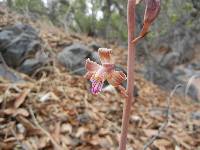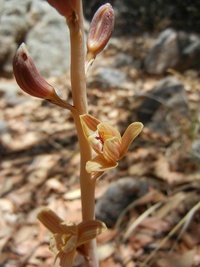Herbs, perennial, terrestrial, leafless, rootless, mycotrophic, solitary or colonial. Rhizomes branching, articulate, annular, stout. Stems erect, yellowish brown, pink, pinkish red, or reddish purple, glabrous; sheathing bracts 2-5, reduced. Inflorescences racemes, consisting of entire aboveground portion of plant. Flowers 2-25, resupinate, tan, brown, magenta, purple, or maroon; dorsal sepal lanceolate; lateral sepals falcate to lanceolate, base distinct and free; petals linear, lanceolate, or elliptic; lip 3-lobed; lamellae 3-5(-7), prominent; column arcuate, apex narrowly winged; anthers terminal, white, yellow, or maroon; pollinia 8, firm, in 4 pairs, 2 pairs per anther cell; stigma subterminal. Fruits capsules, pendent, ellipsoid; seeds 0.5-0.7 mm.
Rafinesque´s choice of the name Hexalectris was probably inappropriate because plants in the genus tend to have five or seven crests on the lip (C. A. Luer 1975; J. Liggio and A. Liggio 1999).
Examination of material, both living and preserved, suggests that a species complex exists that involves Hexalectris nitida, H. revoluta, H. spicata in the broad sense, and the Mexican and Guatemalan H. parviflora. This is a complicated group, some plants of each species resembling plants of another species within the complex. Hexalectris spicata var. arizonica possibly is a hybrid-derived taxon from H. nitida and H. spicata var. spicata, or the latter species and H. revoluta (P. M. Catling and V. S. Engel 1993), although plants with cleistogamous flowers of H. nitida are often similar to H. spicata var. arizonica. A number of recent significant range extensions have been noted for H. nitida (V. S. Engel 1987), H. revoluta (R. A. Coleman), and H. warnockii (V. S. Engel 1987; G. A. Salazar-Chavez 1991), suggesting that members of this genus lurk unsuspected over a very large geographic area; they may be more common than currently assumed. Because relatively few herbarium collections have been made for this genus, particularly in the western United States and Mexico, it is clear that more has yet to be understood about the biology and taxonomy of the members of this complicated genus. Based on plastid DNA sequences, it has been estimated that Hexalectris is most closely related to the neotropical genera Basiphyllaea and Bletia (D. H. Goldman 2000; D. H. Goldman et al. 2001).
Sep and lateral pet similar, 5-7-veined; lip 3-lobed, usually with 5-7 longitudinal ridges convergent below and extending nearly to the tip; lateral lobes of the lip upturned and partly embracing the fleshy, distally dilated column; anther terminal, with 8 pollinia, yellowish or brownish to purplish, nongreen mycotrophs arising from a cluster of coralloid rhizomes; stem bearing a few sheathing scales and a loose terminal raceme of dull yellow fls striped with purple. 7, N. Amer., esp. Mex.
Gleason, Henry A. & Cronquist, Arthur J. 1991. Manual of vascular plants of northeastern United States and adjacent Canada. lxxv + 910 pp.
©The New York Botanical Garden. All rights reserved. Used by permission.






